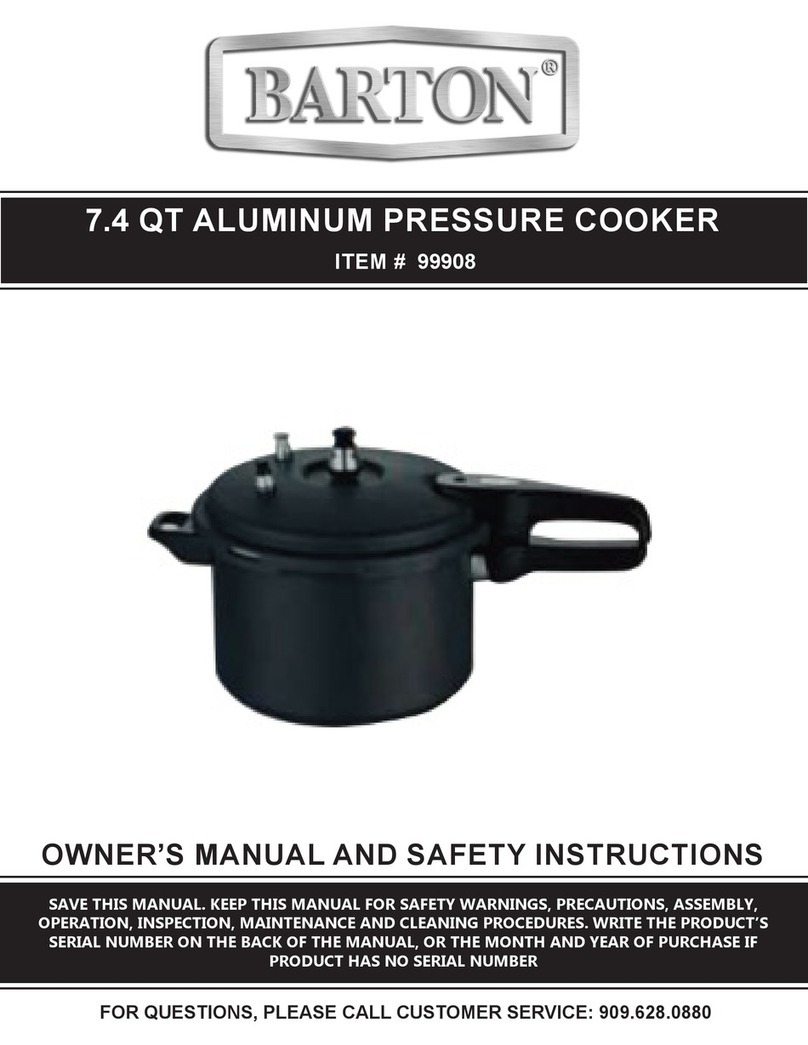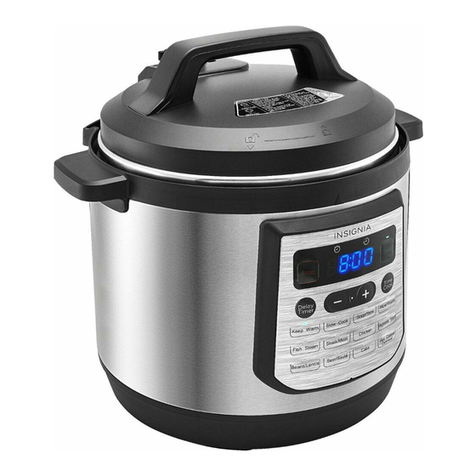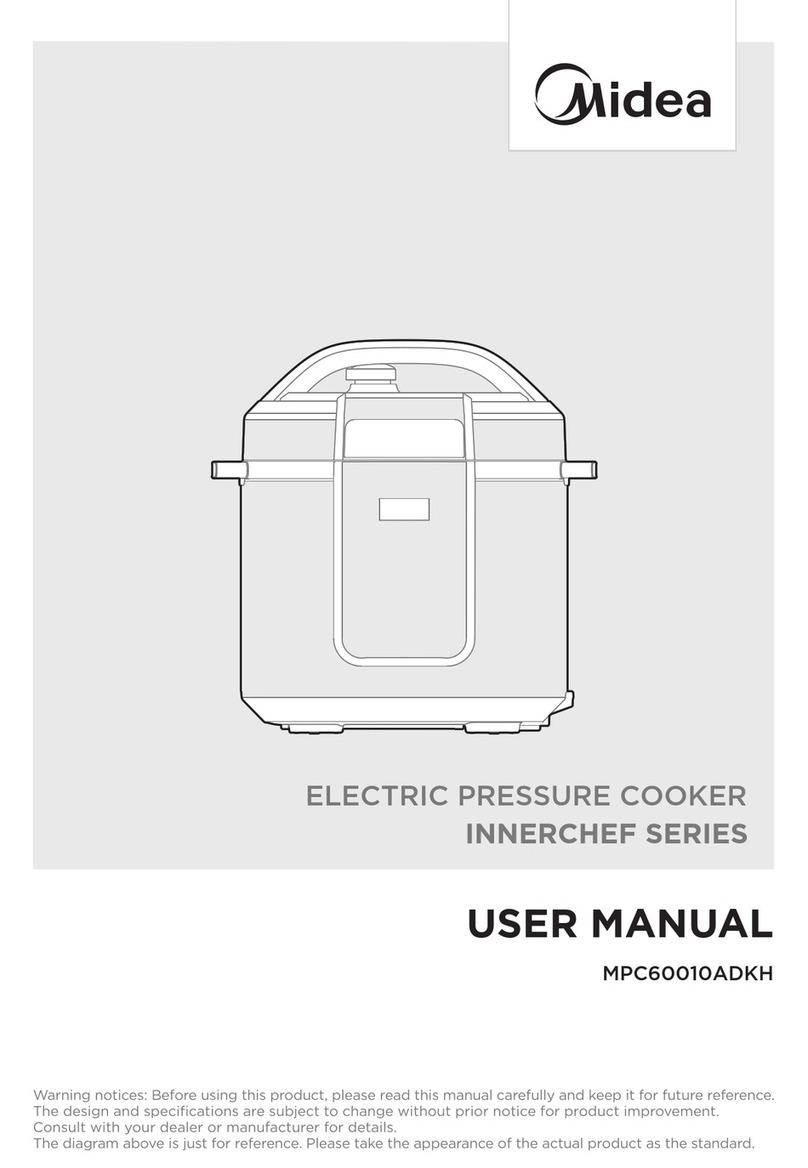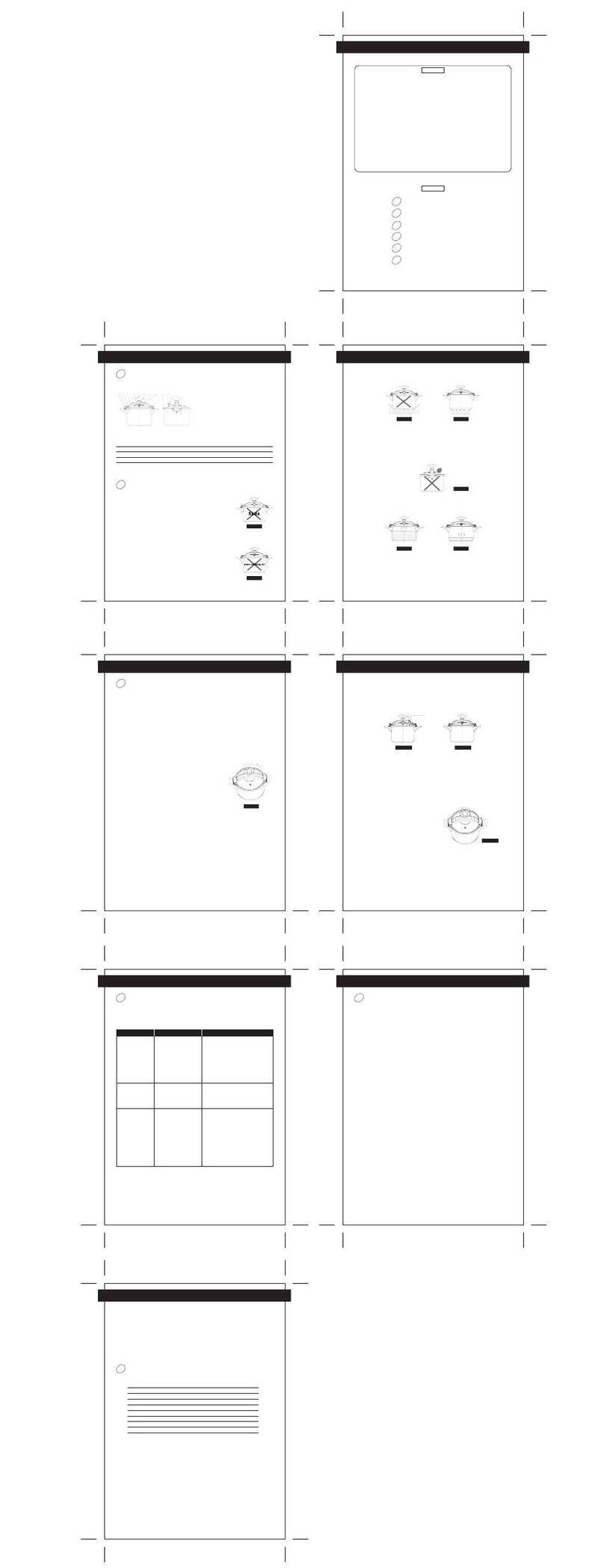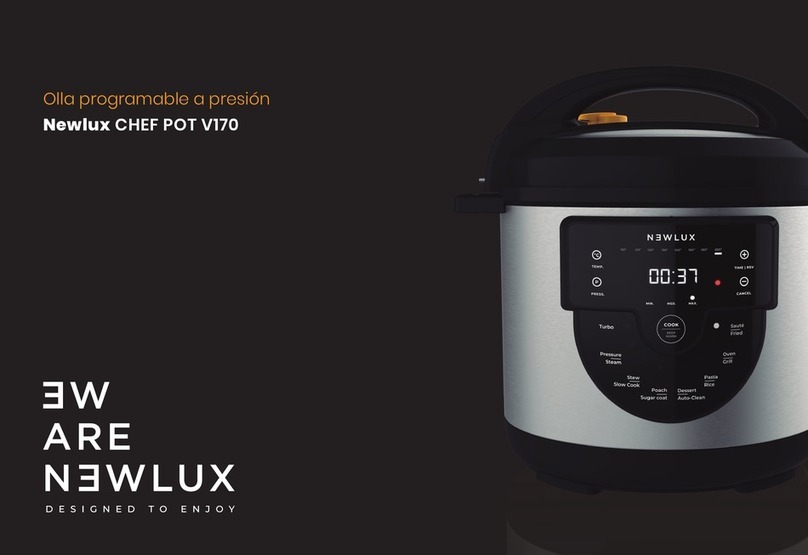Barton 99943 Original instruction manual

OWNER’S MANUAL AND SAFETY INSTRUCTIONS
PRESSURE COOKER
ITEM # 99943, 99944, 99945
SAVE THIS MANUAL. KEEP THIS MANUAL FOR SAFETY WARNINGS, PRECAUTIONS, ASSEMBLY,
OPERATION, INSPECTION, MAINTENANCE AND CLEANING PROCEDURES. WRITE THE PRODUCT’S
SERIAL NUMBER ON THE BACK OF THE MANUAL, OR THE MONTH AND YEAR OF PURCHASE IF
PRODUCT HAS NO SERIAL NUMBER
FOR QUESTIONS, PLEASE CALL CUSTOMER SERVICE: 909.628.4900

SAFETY WARNINGS
Read all safety warnings and instructions. Failure to follow the warnings and instructions may result in
injury and/or property damage. Save all warnings and instructions for future reference.
The warning and safety instructions in this manual are not meant to cover all possible conditions and
situations that may occur. Common sense, caution and care must be exercised when operating or
cleaning tools and equipment. Always contact your dealer, distributor, service agent or manufacturer
about problems or conditions you do not understand before operating the product.
SAVE THESE WARNINGS.
1
Do not allow children or pets near the pressure cooker while in use.
Do not put the pressure cooker into a hot oven.
Move the pressure cook with care. Do not touch the hot surfaces of the pressure cooker. Use gloves when moving the
pressure cooker.
Never use your pressure cooker without adding water, this would seriously damage it.
Do not ll the cooker beyond 2/3 of its capacity. When cooking foodstus which expand during cooking, such as rice or
dehydrated vegetables, do not ll the cooker to more than half of its capacity.
Use the appropriate heat source(s) according to the instrucons for use.
Before each use, check that the valves are not obstructed.
Only use manufacturer’s spare parts in accordance with the relevant model.
Never cover pressure valves on the pressure cooker. An explosion can occur causing burns. Replacement of the pressure
regulator is not recommended.
Place the pressure regulator only when steam releasing from the vent pipe. Close supervision is necessary unl the
steam releases regularly from the pressure regulator.
The safety valve emits excessive steam shows that the inside pressure rises over the safety pressure. Turn heat o
immediately if this happens and let the pressure cooker cool down then check and clean the vent pipe and block-proof
cover.
This appliance is not intended for use by persons, including children with reduced physical, sensory and/or mental
capabilies, or lack of experience and knowledge, unless they have been given supervision or instrucon concerning
use or supervision concerning use of the pressure cooker.
Do not use the pressure cooker if it is damaged or deformed in any way. Return the pressure cooker to nearest authorized
dealer or manufacturer. Contact customer service with any quesons or concerns.
Don’t use this pressure cooker for deep-frying, and never place this pressure cooker in the oven, as this would destroy
plasc and rubber parts and the safety mechanisms.
Never use your pressure cooker without adding liquid, as this could result in damage from overheang to the cooker
and the burner. Adhere strictly to the following content amounts: Minimum: 1/4 liter of liquid. Maximum: 2/3 of the
volume of the pressure cooker. For foods which foam or rise (e.g. rice, legumes, broths, or dried vegetables), 1/3 of the
volume of the cooker.
2

SAFETY WARNINGS
SAVE THESE WARNINGS.
1
SAFETY WARNINGS
2
Pressure cookers are under pressure when in use. Not adhering to the Instrucons for Use can lead to burns and
scalding. Make sure that the cooker is properly closed, and never cover the Pressure limited valve before it is heated up.
Keep an eye on the pressure cooker while cooking. If the steam escape through push proof valve, or rubber gasket
escape through safety window, in this case, turn o the heat on your stove immediately and check the reason, solve
the problem, then go on using.
Move the pressure cooker very carefully when it is under pressure. Do not touch the hot outer surfaces of the pressure
cooker, as you could burn yourself by doing so. Only touch the handles when cooking, and use potholder gloves when
necessary.
Pressure cookers must be shaken before opening to avoid pockets of steam, which might be caught within the food
from spaering up and scalding you. Do not cook applesauce or stewed fruits in a pressure cooker
Never try to force the pressure cooker open. Do not open it before you are certain that the steam inside has been
expelled completely.
Do not let the safety window aim at user while cooking. Always keep your hands, head and body out of the danger zone
when releasing steam from the pressure cooker.
Do not alter the safety mechanisms at random. Do not repair or oil the valves. If the pressure cooker-or any of its
parts-is damaged or does not funcon as described in the Instrucon for Use, do not use the pressure cooker. Let a
professional repair it or get in touch with your retailer.
Push proof valve: Only when the cooker is properly close, the pressure inside cooker should start to raise, then the
Push-proof rod will rise to lock the lid.
If the cooker is not closed properly, the pressure inside the cooker can’t rise and the steam will always escapes from the
Push proof valve. In this case, you should turn o the heat, close the cooker properly.
Push proof valve can indicate the pressure state inside the cooker automacally. As long as the pressure inside the
cooker is lower than the pressure that can engages the safety mechanism you can open the cooker safely Push-proof
rod will fall back into its socket completely, then you just can open the cooker.
Safety valve: When the Pressure limited valve doesn’t work or can’t work well and the pressure inside the cooker is
too high, the Safety valve will work automacally, release redundant steam in the cooker, keep the pressure cooker at
a safe level.
Safety window: There is a safety window at the edge of the lid. When both the Pressure limited valve and Safety valve
don’t work and the pressure inside the cooker is too high, the rubber gasket will be extruded from this window, and it
can depressurize the cooker quickly to the safe state.

PRODUCT INFORMATION
3
HOW PRESSURE COOKER WORKS
TECHNICAL PARAMETERS
In the process of heang, the cooker is sealed by a silicon sealing ring, pressure in the cooker is increasing gradually, and
boiling point of water is increasing accordingly. When pressure in the cooker exceeds the specied limit, the pressure
regulator is pushing up, allowing steam to escape from the vent pipe keeping temperature and pressure inside the cooker
at a certain level. If the escaping hole is blocked by food, one of the two safety valves will exhaust steam automacally for
safety assurance. To ensure safe operaon once lid is properly closed it will lock in this posion when pressure reaches a
certain point.
1. Cooker body
2. Lower handle
3. Sealing ring
4. Safety Valve
5. Clamp
6. Lid panel
7. Pressure Indicator
8. Lid
9. Turn Knob
10. Pressure limited valve
11. Vent pipe
OPERATION
4
SAFETY WARNINGS

PRODUCT INFORMATION
3
OPERATION
4
FEATURES OF PRESSURE COOKING:
1. Save me, preserves food up to 30%~70% faster than ordinary cooking methods.
2. Using less energy and saving more money. Keep kitchens cool and lower fuel bills. During the modern busy day, you can
prepare a complete homemade gourmet meal in minutes.
3. Pressure cooking helps to retain your food essenal nutrients. Cooking in an almost airless cooking environment with
just a lile liquid, Flavor is enhanced and food valuable vitamins and minerals are retained.
OPENING THE PRESSURE COOKER:
Make sure the cooker is not pressured right to be opened, put it on a horizontal table or place and turn the turning handle
toward the direcon the arrow marked on the handle(open), unl the turning handle and the lid control panel are in the
shape of a cross. You will hear the sound ‘KA’. then li the lid.
CAUTION:
• Servicing or repair should only be completed by a qualied technician.
• Don’t tamper with the pressure cooker, you may damage the safety systems and prevent their operaon.
• Don’t dismantle any part of the pressure cooker unless directed to do so in instrucons.
• Using aachments not recommended or sold by the manufacturer may cause hazards. Only use original spare parts.
Use Capacity
Do not ll up the pressure cooker over 2/3 of its full capacity. When cooking foods that expand during cooking such as rice
or dried vegetables, do not ll the unit over 1/2 full. Over lling may cause a risk of clogging the vent pipe and developing
excess pressure.
SAFETY WARNINGS SAFETY WARNINGS
PRIOR TO USING PRESSURE COOKER:
• Check to see that the Pressure limited valve, Block proof cover and Vent pipe does not sck and are in place in the lid
and they will funcon properly.
• Check to see that the rubber gasket is correctly in place in the lid.
• Make sure that you always have the proper amount of liquid in the pressure cooker before it is closed.
Maximum volume: The maximum volume for common food is 2/3 of the cooker’s capacity. For foods that swell or foam
(e.g. legumes, rice, noodles, broths, or dried vegetables), the volume is then 1/3 of the cooker’s capacity.
Minimum volume: Please remember that the cooker must always contain at least 1/4 liter of liquid when cooking.
• Using aachments not recommended or sold by the manufacturer may cause hazards. Only use original spare parts.

OPERATION
5
Important: Always add enough liquid for steam to form, and make sure that the liquid in the pressure cooker does
not evaporate completely. Never allow the cooker to “cook unl dry.” As the resulng overheang could damage the
cooker (e.g. melt the base or damage the safety mechanisms) and the burner. In case of overheang, never remove the
cooker from the burner. Simply turn o the burner and let the cooker cool down for a while on it.
Close and Open the Lid
Put the lid on the cooker body. At rst, make sure the lid is in opening state.
Then turn the turning handle toward the direcon the arrow marked on the
handle(close), unl the turning handle and the lid control panel are in a line.
To begin cooking
Place the pressure cooker on the proper burner; the diameter of burners should be
always smaller than the diameter of pressure cookers. And make sure the releasing vent
toward the working mark points, not toward the releasing mark points.
End of Heang
Remove the pressure cooker from the source of heat, reduce pressure before opening the lid. Set the cooker aside to a
cool area and wait the cooker body cool down or for quicker reducon of pressureNever force the cooker open. It may
only be opened as long as the indicator rod has fallen back into its socket completely. Always shake the cooker before you
open it. This will prevent pockets of steam, which might be caught within the food from spaering up when the pressure
cooker is opened. If you do not do so, you are in serious danger of suering burns and scalding by the escaping steam and
food.
WARNING: Do not hold the pressure regulator to release pressure. (Risk of injuries! Hot steam/liquid will be ejected.)
Keep hands and face away from steam vent pipe, use cooker handles when removing the cooker or touching any hot
items, and never force the lid open. The lid will only open once the pressure is released. Remove the lid by liing it away
from you to avoid being burned by the steam.
Always begin with the burner at high. When using a gas stove, make sure that the ame does not go beyond the edge of
the pot base.
When cooking begins, the temperature rises and the process begins
automacally. Steam escapes from Push proof valve, taking with it the oxygen
in the air, which can destroy vitamins and minerals. This process may take a
few minutes. The Push proof valve closes automacally. Aer few minutes,
The rst white ring on the indicator rod becomes visible.
• The 1st white ring on the indicator rod means that the pressure cooker is
under pressure and can’t be opened. It will be visible in the whole process of
cooking.
• For the 2nd red ring ,when the pressure cooker works normally, the red ring
won’t appear. If the red ring rises and appears in the process of cooking, It
means the pressure is too high inside the cooker, in this case, turn down the
heat and check the reason.
To begin cooking
Place the pressure cooker on the proper burner; the diameter of burners should be always smaller than the diameter
of pressure cookers. And make sure the releasing vent toward the working mark points, not toward the releasing mark
points.
NOTE: If the 2nd red ring appears and connues to rise, you will hear a hissing sound, and the excess steam will escape
through the Pressure limited valve. This means that the temperature is too high and the burner must be turned down,
otherwise the liquid will evaporate completely.
OPERATION

OPERATION
5
WAYS TO RELEASE PRESSURE FROM THE COOKER:
A. Cool the cooker under running water:
Hold the cooker under the water tap and run gently owing cold water over the lid-but not over the lid control panel or
pressure limited valve-unl the Push-proof rod has fallen back into its socket completely. Do not place the cooker in water.
OPERATION
B. Release steam
Move the pressure limited valve unl the releasing vent toward the releasing mark points, the steam will stream out from
the releasing vent on pressure limited valve. It may take several minutes. When the Push-proof rod has fallen back into its
socket completely, no more steam is escaping from pressure limited valve. Then shake the cooker gently, open the cooker.
C. Set aside to cool o
By this way, it takes quite a while for depressurizing. It should not be used for foods with very short cooking mes, such
as sh or vegetables, for they can easily become overcooked while the cooker is cooling down. When the Push-proof rod
is no longer visible, shake the cooker gently when opening.
6

MAINTENANCE
7
VI. CLEANING/MAINTENANCE
CLEANING
Once cook has nished, take the food out of the cooker. Aer the unit has cooled, remove the lid, clean the cooker in case
that the food, especially acidic food, erodes in the cooker. Do not use abrasives to clean the pressure cooker.
VENT PIPE AND BLOCK-PROOF COVER:
Aer each use, turn the lid over and place on a table top, then pull out the block-proof cover and clean it with water, if
necessary, use a pin or something similar to clean the hole to ensure that there are not any food or foreign parcles that
may be lodged in the vent pipe and block-proof cover.
SAFETY VALVE:
Every pressure cooker is equipped with safety valve, make sure both are workable before use cooker each me. Clean the
base of the safety valve inside of the lid, check that it is working correctly by pressing lightly on the valve, which should
give way easily. If not, replace with spare parts.
CHANGE THE SEALING RING
Make sure that you buy the correct gasket for your model. Aer the pressure cooker is used, the sealing ring should be
washed with hot water or detergent. Soak it in soapy water for a few seconds, then put it in posion. Be careful not to
fold or deform the sealing ring. Never shorten the gasket. If there are aws on the sealing ring, or the sealing ring become
old, please replace a new ring.
FLOATING VALVE
Push down the rod with one hand; push the oang valve upward with the forenger of the other hand to see if the
oang valve works freely. If not, wash the oang valve assembly with water directly or dismantle the lid handle and
then wash it. Replace it with oang valve assembly if necessary.
• How to replace the components in the lid handle If replacement is necessary, please insert spring rst into the end of
the push rod. Then put them both in the sliding groove of the lid handle. Finally screw the lid handle and the lid together.
STORAGE OF YOUR PRESSURE COOKER
Aer use, clean and dry the cooker to keep. Turn the lid upside down on the body to ensure that pressure cooker lasts as
long as possible.
WARNING:
Do not use your pressure cooker to store acidic or salty food before and aer cooking. Repair or other servicing should
be performed only by a qualied technician or authorized service representave.
MAINTENANCE
RECOMMENDED COOKING TIMES (times may vary depending on weight and qty)

7
TROUBLESHOOTING
8
MAINTENANCE COOKING TIME

10
OF NOTETROUBLESHOOTING
9

OF NOTE
10
PLEASE READ THE FOLLOWING CAREFULLY
THE MANUFACTURER AND/OR DISTRIBUTOR HAS PROVIDED THE PARTS LIST AND ASSEMBLY
DIAGRAM IN THIS MANUAL AS A REFERENCE TOOL ONLY. NEITHER THE MANUFACTURER OR
DISTRIBUTOR MAKES ANY REPRESENTATION OR WARRANTY OF ANY KIND TO THE BUYER THAT HE
OR SHE IS QUALIFIED TO MAKE ANY REPAIRS TO THE PRODUCT, OR THAT HE OR SHE IS QUALIFIED
TO REPLACE ANY PARTS OF THE PRODUCT. IN FACT, THE MANUFACTURER AND/OR DISTRIBUTOR
EXPRESSLY STATES THAT ALL REPAIRS AND PARTS REPLACEMENTS SHOULD BE UNDERTAKEN
BY CERTIFIED AND LICENSED TECHNICIANS, AND NOT BY THE BUYER. THE BUYER ASSUMES
ALL RISK AND LIABILITY ARISING OUT OF HIS OR HER REPAIRS TO THE ORIGINAL PRODUCT OR
REPLACEMENT PARTS THERETO, OR ARISING OUT OF HIS OR HER INSTALLATION OF REPLACEMENT
PARTS THERETO.
Record Product’s Serial Number Here:
Note: If product has no serial number, record month and year of purchase instead.
Note: Some parts are listed and shown for illustration purposes only and are not available
individually as replacement parts.
MADE IN CHINA
OF NOTETROUBLESHOOTING
This manual suits for next models
2
Table of contents
Other Barton Electric Pressure Cooker manuals
Popular Electric Pressure Cooker manuals by other brands
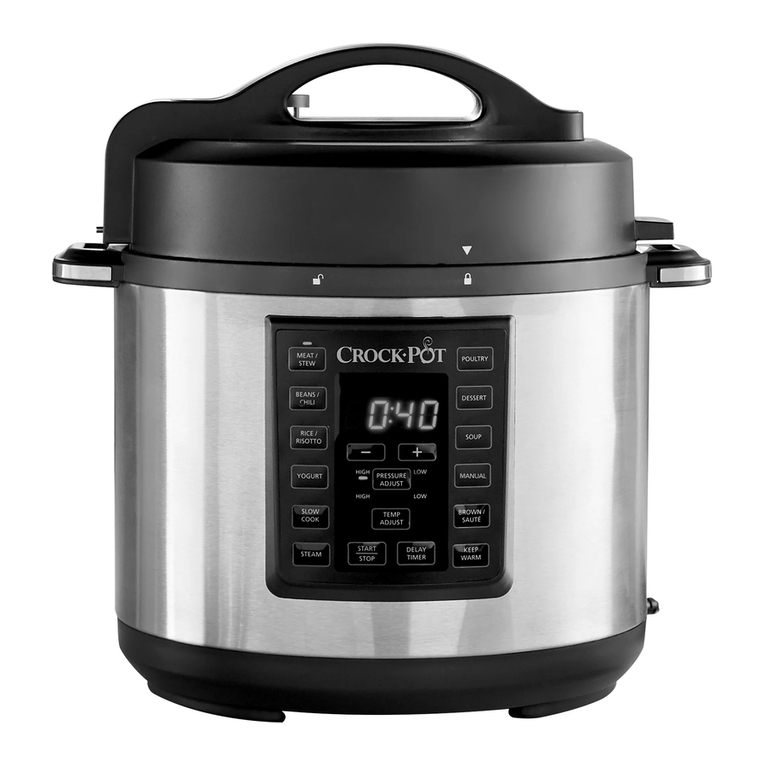
Crock-Pot
Crock-Pot CSC051 user manual

Crock-Pot
Crock-Pot EXPRESS Easy Release 10 Qt owner's manual

InstantPot
InstantPot DUO CRISP Safety, Maintenance & Warranty
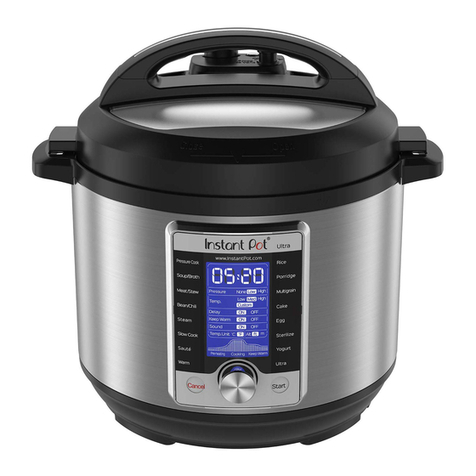
InstantPot
InstantPot ULTRA Series user manual
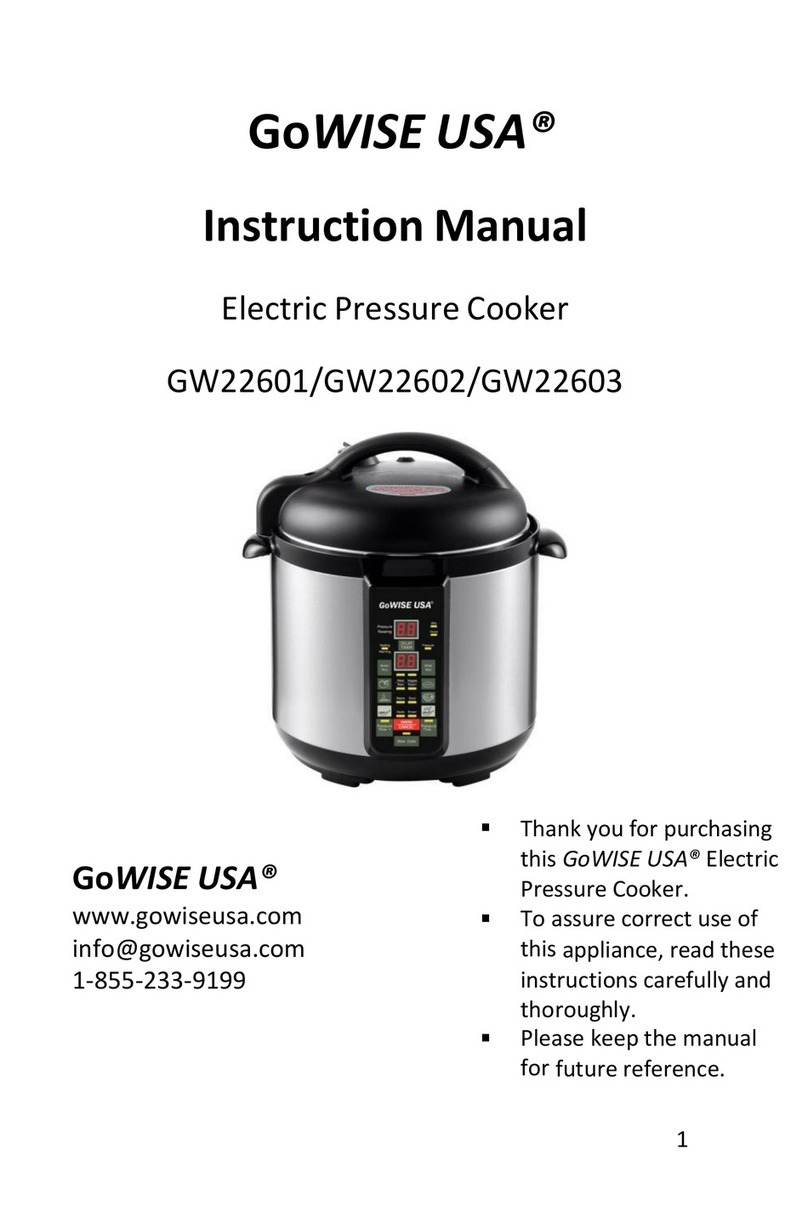
GoWISE USA
GoWISE USA GW22601 instruction manual

Wolfgang Puck
Wolfgang Puck BPCR0275 Signature Collection manual

Paula Deen kitchen electrics
Paula Deen kitchen electrics PDPC8 Instruction manual & recipes

Amway
Amway Noxxa manual
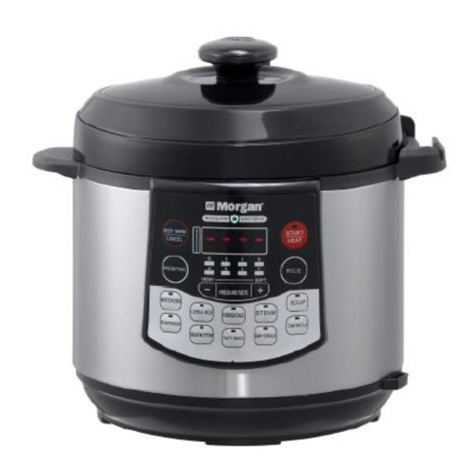
Morga
Morga MPC-136A user manual

CONTINENTAL EDISON
CONTINENTAL EDISON CEMCSP1000I instruction manual

PoongNyun
PoongNyun Vertu series user manual

Scarlett
Scarlett Silver Line SL-1529 instruction manual
